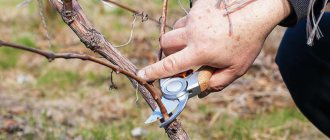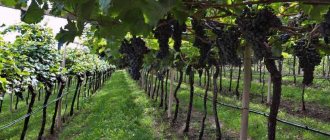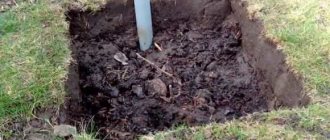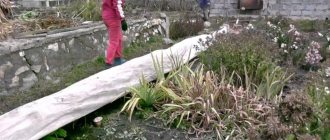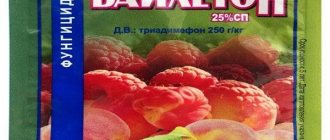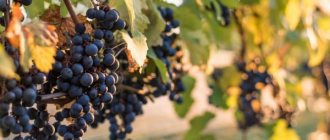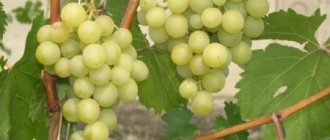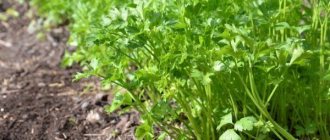| Name | Diamond | Berry color | Black |
| Selection | Pavlovsky E.G. (Super-Extra x Pretty) | Bunch weight | 300 g. |
| View | Dining room | Sugar content | Brix 18-20 |
| Ripening time | Ultra-early (80-90 days) | Bushes | Very strong growth force |
| Frost resistance | Average(-23…-24°С) | Sustainability | To oidium and mildew at the level of 3-3.5 points, no gray mold damage was observed |
| Productivity | Low | Presence of a bone | Present (1-3 seeds) |
Description of the variety
The hybrid form Rombik impresses with its early ripening and is suitable for cultivation throughout Russia. The ripening of the vines is good, as is resistance to the main diseases in the vineyard: oidium and mildew. The taste doesn’t seem to be anything - a little tart skin and large seeds, but thick crispy flesh with fruity notes of prunes and black currants. What does Rombik lack to become a clear leader among early ripening new products? But the yield is not enough. The clusters of the form are literally 250-300 g, pollination is also not the best, hence the low total yield, even taking into account the load of 2 clusters per shoot. The second obvious drawback is the cracking of the berries after rain, although this disadvantage is not as obvious as with the “mother” Pretty, but the Diamond still cracks.
If we summarize all of the above, we get very simple conclusions: Diamond is not suitable for mass planting, but planting 1-2 bushes and enjoying early grapes is quite a worthy option.
Bushes
- flowers are bisexual;
- bushes of great growth vigor;
- The fruitfulness of the shoots is high - we leave 2 bunches per shoot;
- early and very good ripening of the vines;
- good rooting of cuttings.
Berries
- medium size, weight: 7-8 g, some specimens reach 10-11 g;
- black color;
- elongated, oval, with a thickening in the middle, one might say diamond-shaped, hence the name;
- waxy coating of medium thickness.
Bunches
- conical or shapeless;
- medium-loose, medium density, berries do not wrinkle when ripe;
- medium size (weight from 500-600 g to 800-1000 g)
Taste
- harmonious with the original fruity aroma of prunes and black currants;
- the pulp is dense, crispy, Super-Extra type;
- the skin is eaten, astringency is felt in the taste;
- sugar accumulation is 18-20%.
In terms of ripening time, the diamond is ahead of the hybrid forms Podar Unsvetaya, Memory of the Teacher and Super-Extra, which are popular for their early ripeness.
Diseases of grapes "Rhombik"
There is a certain number of diseases that the Rhombik grape variety encounters one way or another quite often. In order to avoid negative consequences and prevent the loss of varieties, let’s take a closer look at them.
- Powdery mildew. Characteristic signs of infection are the appearance of a coating of grayish-white plaque with an unpleasant smell of rot. If nothing is done, the inflorescences will wither and fall off. To prevent infection, treat the bush with appropriate preparations.
- Mild. A yellow or green coating appears on the leaves: if you do not resort to treatment, the leaves will begin to fall off. To prevent infection, it is necessary to provide the bush with good air exchange, promptly removing weeds and affected leaves, if any.
- Anthracose. If the diseases mentioned above are not treated, this leads to anthracosis, as a result of which the bush dies. Anthracose is treated with Bordeaux mixture.
Landing
To plant grapes, choose the sunniest place on the site. It is not allowed to plant in the shade of trees or on the north side of buildings or a fence, but on the south, on the contrary, is the best option. Such buildings will protect the grapes from cold northern winds, screen the sun's rays, heat up during the day and gradually release heat at night. The main thing is to maintain a distance of at least 70 cm from the foundation. Groundwater must be located at a depth of at least 1.5 m.
The optimal arrangement of rows of grapes, for better illumination, is from north to south. The distance between bushes is 2.5 m, between rows is also 2.5 m.
The distance between bushes in a row is 2.5 m, row spacing is also 2.5 m.
Hole dimensions: depth 60 cm, length and width 50 cm.
Composition for filling the hole:
The size of the holes is 60x60x60 cm. Pour 15 cm of nutritious soil into the dug hole (the composition is indicated in the picture above), lightly sprinkle with earth so that the roots do not come into contact with fertilizers, and also scatter a little Vallar preparation for the larvae of the cockchafer. We install the seedling, sprinkle it with a little earth, and then with nutritious soil (about 15 cm). We don’t fill the entire hole! The hole must be preserved; we will sprinkle it as the bush grows. Deep landing solves 2 problems at once. Firstly, it allows you to form the sleeves of the bush as if from the ground, so it will be easier to cover them for the winter, secondly, the roots are at a depth of about 50-60 cm, a layer of earth will protect them well from freezing (grape roots freeze out at a temperature of -5 …-7°С). For the first 2 weeks, shade the seedling from direct sunlight.
Advantages
The Rombik grape has a number of advantages. Gardeners who have connected their lives with this variety highlight the following advantages:
- This is one of the earliest varieties.
- With the right agricultural technology, you can get a high yield.
- The fruits are distinguished by their excellent taste.
- The bunches and berries have a good presentation, thanks to which they are quickly sold out on the market.
- The variety is not afraid of long-term transportation over long distances.
- Rombik grapes have a relatively high level of immunity, which protects it from most dangerous diseases.
- Diamond is distinguished by high frost resistance.
There are not many varieties in the world that ripen so quickly. In general, winegrowers note this advantage as the main one.
Recommended by topic
Anthony the Great grapes are large, tasty, powerful. Are there any disadvantages? Tsimus - the earliest of the sultanas Kishmish Halloween (Witch's fingers) - one of the most unusual new products of recent years
For watering around the bush, you can make baths with sides made of earth, about 10 cm high. You can simply throw a hose into such baths and move it to a new place when the bath is completely filled and the water stops being absorbed. The question is often asked whether I water with warm or tap water. I have to water it with water from a well, and it is simply unrealistic to heat the volume of water I need in the tank (it takes 100 and 150 liters when watering an adult bush). Watering consists of lowering the hose into the bath and making sure that the water does not overflow over the sides, so the bush itself controls the volume it needs.
I definitely water it a week before flowering, and 2 waterings when the berry is in pea state. During flowering and coloring of berries and in general after August 1, I do not water.
The diamond is prone to cracking and the problem can be solved in two ways: someone waters the bushes while coloring the berries with small portions of water, so that after rain there is no sharp difference in the volume of moisture consumed and the berries do not crack, someone, on the contrary, limits the flow of water in every possible way by pulling polyethylene or banner over the bushes. I personally don’t do anything, it doesn’t happen year after year, but there are still more seasons when the Rombik doesn’t crack.
We water annual seedlings weekly in dry, hot weather.
Feeding
With fertilizing grapes, everything is simple - in the spring and early summer we give nitrogen fertilizers to increase the green mass. Herbal infusions, infusions of mullein or chicken are suitable here. If there is nothing, then you can use mineral water - calcium nitrate or urea (urea).
Personally, I use mullein, and I don’t bother fermenting it. I just mix a bucket of fresh horse or cow manure with a bucket of water, around the bushes I make baths out of the ground, with sides of about 10 cm, fill them with several buckets of water and pour in one or two liter jars of diluted mullein.
A good result can be obtained by using the popular Plantafol, they work with it on the sheet; variations of Plantafol depending on the time of year are shown in the pictures.
Processing by leaf in May. Nitrogen content 30%
Processing by leaf in June. A large amount of phosphorus stimulates the formation of a large number of inflorescences
Since August 1st we have been using the 5:15:45 train. The minimum amount of nitrogen will not allow the shoots to fatten, the vine will ripen well
We do not feed Rombik with nitrogen fertilizers after August 1st! At this time, the grapes need to first of all be helped with the ripening of the crop and vines. Potassium fertilizing using potassium monophosphate will have a good effect. Such fertilizing is carried out once a week, increasing the concentration by 10 g weekly, starting from 40-50 g/10 l. and ending with 120 g/10 l. water.
Green operations
- We normalize the plant by shoots: we remove all doubles, tees, shoots located below the first wire (height 60 cm), there should be a distance of at least 15 cm between vertical shoots, if the shoots are more frequent, then we break out some of them.
- The diamond does not need to be rationed by the harvest, the clusters of the shape are small, 2 clusters can be left on each shoot.
- We pinch the stepsons as they appear above the first leaf.
- We remove the tops of the shoots as soon as they reach the top wire of the trellis.
Treatment against diseases and pests
Rombik has good resistance to the main diseases of grapes - mildew and oidium, however, any disease is easier to prevent than to treat. Moreover, fungi usually appear closer to harvest, and at this time the use of chemicals is strictly prohibited.
We spray the grapes 3 times - when 4-5 leaves appear on each shoot, before flowering and when the berries are at the pea stage. There are many processing tools, one of the options is:
- a solution of 1% Bordeaux mixture, I also add Ecosil to it, but you don’t have to add it;
- tank mixture of preparations: Falcon 5 ml./10 l. and Ridomil Gold 25 g/10 l.;
- I repeat the preparations from the second treatment or spray with the preparation Strobi, it immediately removes both mildew and oidium.
Ticks are a rare occurrence in my area. If you are fighting mites, for example, on strawberries, then they can also spread to grapes; you should add Actellik, Fufanon (10 ml/10 l.) or any other acaricide to the tank mixture. In warm weather, you can do without chemicals - treat the bushes with Fitoverm.
Mildew
Oidium
Mite
Shaping, trimming
Briefly about the formation:
- In the first year, we grow one shoot from the seedling, removing all the stepsons, and in the fall we prune it back to growth, leaving 3 buds;
- In the second year, shoots will begin to develop from the buds; we remove the shoots on them during the season, and trim them in the fall, keeping in mind that these shoots will act as sleeves and you will place them on the trellis wire next season. That. you don’t need to leave them very long, otherwise one bush will overlap another, for example, there are 2.5 m between the bushes and you want to place the sleeves towards each other, which means they should reach just one to the other, 1.25 m for each bush, cut it that way.
- In the third year, we place the sleeves grown last year horizontally on the bottom wire, vertical shoots will grow on them and the first harvest will begin; also, several more sleeves need to be grown from the head of the bush this season.
- In the autumn of the third year we inspect each sleeve, our task is to leave only one vertical shoot, it will be the growth of the sleeve, it is desirable that this shoot be closer to the head of the bush, otherwise in a few years it will simply be impossible to bury the sleeves, they will be very long. All shoots and part of the sleeve coming after the left shoot are removed. We carry out this operation year after year.
Diseases and pests
Diamond is well resistant to diseases and pests, but it is better to carry out treatment for additional safety than to deal with “sores” later. There are many variations of grape treatments, for example, a solution of Bordeaux mixture (1%), a mixture of the preparations “Falcon” (5 ml for 10 liters) and “Ridomil Gold” (25 g for 10 liters), “Strobi”.
Anthracnose
The first thing that suffers from anthracnose is grape leaves, which become covered with black spots on the outside and inside. Over time, these areas enlarge and dry out, and the leaves fall off. Small spots of silver color with a dark border appear on the grape vine. Gradually they merge, forming deep cracks. The brushes of the variety may become covered with brown spots, increasing in size and leading to the death of the tissue.
It is possible to cure Rhombik. When the first symptoms appear, use a 3% solution of Bordeaux mixture, and a week later the Rombik treatment is repeated, but with a 1% solution. At an early stage, a solution of copper sulfate helps, and in case of severe infection, the drugs: “Ordan”, “Kuproksat”, “Acrobat MC”, “Fundazol”, “Previkur”.
Bacterial necrosis
Bacterial wilt affects the above-ground part of Rhombik. Symptoms:
- At first, the growth of the variety's shoots slows down;
- Black spots appear on leaves and branches;
- The buds of the variety are deformed;
- The nodes become fragile;
- Black cankers appear on old branches of Rombik. The young vine becomes ugly and its clusters turn black.
To rid Rombik of necrosis, use a 5% solution of Bordeaux mixture or preparations containing copper. Repeated treatment is carried out with a 2% solution.
Lace borer larvae
The goldfish is a small green beetle with a long body. Damage to grapes is caused by both adults and larvae. They gnaw holes in the shoots and spend the winter there. The leaves of the variety dry out, the stems wither, and the yield of Rombik decreases. Pests are controlled using insecticides, cutting out and disposing of damaged areas.
Preparing for winter
The easiest way to cover grapes for the winter is to cover them with earth. The procedure should not be carried out very early; it is advisable for the vine to harden and undergo several frosts with a temperature of -1...-3....-5°C. Such frosts and gradual decline are not scary for the grapes; the plant is afraid of sudden changes, when today it is +15°C and tomorrow it is -10°C. For shelter, a trench about 15-20 cm long is dug, and tied vines are placed in it. There are times when they did not have time to cover the grapes, frost set in and it is no longer possible to work with the soil - it is frozen. In this case, the construction of a tunnel shelter will help, when the bushes are laid on the ground, small arcs are installed above them and covered on top with non-woven material, for example, spunbond, density 60 in 2 layers.
Grape varieties with photos for the market and their characteristics. Jogging through the vineyard of Sergei Sidoryaki.
Description and characteristics of the Gift of Zaporozhye grape variety, advantages, disadvantages and cultivation
So, in order of our run (I would like to note that he only grows table varieties). We started with Dunav, it had already been cut, there were a couple of substandard bunches hanging to try, there was nothing to take pictures of. To be honest, I was pleased with it; it was not for nothing that I planted a row for myself. The characteristics of this grape variety are as follows: the color is very bright, although a little dark and turns into burgundy, the appearance is awesome. In terms of taste, the taste is simple, but not bad, varietal. When I tried it at Sergei’s, I didn’t like it, but when I tried it at home, I liked it. Especially after saying that these grapes (Dunav) are of no taste. In short, it's a market grade variety, so it's a credit. Next is Galahad. This variety is probably tormenting the minds of most winegrowers now :). I think for another 2-3 years it will be in leading positions in the catalogs of varieties and hybrid forms of grapes for many winegrowers who are engaged in its propagation. Well, what can I say about its characteristics, the size of the berries in the bunch is decent, all the berries are even, the ripening period is also very, very... But! The taste is simple, you couldn’t imagine anything simpler. And the color... Well, the beautiful market color of white table grape varieties is obtained by Victoria Romanian and Arcadia in the shade, so matte with yellowness, very beautiful. But this one is not like that. In short, it’s not clear with him yet, we’ll see what other reviews there are. And for a family at the dacha, I wouldn’t plant these grapes at all, but would plant the Blestyashchiy variety, for example, its stability characteristics are the same, but the taste is there, well, the berries are smaller, so what?
Ataman! And this one has not yet reached its size. But again, timing...
Reproduction
During autumn shaping, a lot of vines are cut out, which is the planting material. We cut the vine into pieces so that each has 3 buds, put it in a cellar, basement or refrigerator, germinate it in March, when the weather is warm, transplant it into open ground.
